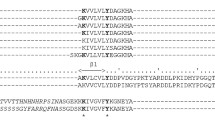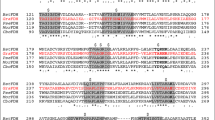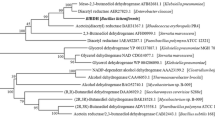Abstract
Objectives
To identify a robust NADP+ dependent formate dehydrogenase from Lactobacillus buchneri NRRL B-30929 (LbFDH) with unique biochemical properties.
Results
A new NADP+ dependent formate dehydrogenase gene (fdh) was cloned from genomic DNA of L. buchneri NRRL B-30929. The recombinant construct was expressed in Escherichia coli BL21(DE3) with 6 × histidine at the C-terminus and the purified protein obtained as a single band of approx. 44 kDa on SDS-PAGE and 90 kDa on native-PAGE. The LbFDH was highly active at acidic conditions (pH 4.8–6.2). Its optimum temperature was 60 °C and 50 °C with NADP+ and NAD+, respectively and its Tm value was 78 °C. Its activity did not decrease after incubation in a solution containing 20% of DMSO and acetonitrile for 6 h. The KM constants were 49.8, 0.12 and 1.68 mM for formate (with NADP+), NADP+ and NAD+, respectively.
Conclusions
An NADP+ dependent FDH from L. buchneri NRRL B-30929 was cloned, expressed and identified with its unusual characteristics. The LbFDH can be a promising candidate for NADPH regeneration through biocatalysis requiring acidic conditions and high temperatures.





Similar content being viewed by others
References
Alekseeva A, Savin S, Tishkov V (2011) NAD+ dependent formate dehydrogenase from plants. Acta Nat 4:38–54
Andreadeli A, Platis D, Tishkov V, Popov V, Labrou NE (2008) Structure-guided alteration of coenzyme specificity of formate dehydrogenase by saturation mutagenesis to enable efficient utilization of NADP+. FEBS J 275:3859–3869
Bommarius AS, Karau A (2005) Deactivation of formate dehydrogenase (FDH) in solution and at gas-liquid interfaces. Biotechnol Prog 21:1663–1672
Davis BG, Celik A, Davies GJ, Ruane KM (2009) Novel enzyme. US patent 20130029378 A1
Ding HT, Liu DF, Li ZL, Du YQ, Xu XH, Zhao YH (2011) Characterization of a thermally stable and organic solvent-adaptative NAD+-dependent formate dehydrogenase from Bacillus sp. F1. J Appl Microbiol 111:1075–1085
Fogal S, Beneventi E, Cendron L, Bergantino E (2015) Structural basis for double cofactor specificity in a new formate dehydrogenase from the acidobacterium Granulicella mallensis MP5ACTX8. Appl Microbiol Biotechnol 99:9541–9554
Galkin A, Kulakova L, Tishkov V, Esaki N, Soda K (1995) Cloning of formate dehydrogenase gene from a methanolutilizing bacterium Mycobacterium vaccae N10. Appl Microbiol Biotechnol 44:479–483
Gao X, Ni K, Zhao C, Ren Y, Wei D (2014) Enhancement of the activity of enzyme immobilized onpolydopamine-coated iron oxide nanoparticles by rational orientation of formate dehydrogenase. J Biotechnol 188:36–41
Gul-Karaguler N, Sessions RB, Clarke AR, Holbrook J (2001) A single mutation in the NAD-specific formate dehydrogenase from Candida methylica allows the enzyme to use NADP. Biotechnol Lett 23:283–287
Hatrongjit R, Packdibamrung K (2010) A novel NADP+dependent formate dehydrogenase from Burkholderia stabilis 15516: screening, purification and characterization. Enzyme Microb Technol 46:557–561
Hoelsch K, Sührer I, Heusel M, Weuster-Botz D (2013) Engineering of formate dehydrogenase: synergistic effect of mutations affecting cofactor specificity and chemical stability. Appl Microbiol Biotechnol 97:2473–2481
Hussain H, Chong NF (2016) Combined overlap extension PCR method for improved site directed mutagenesis. Biomed Res Int 2016:8041532
Klibanov A (2001) Improving enzymes by using them in organic solvents. Nature 409:241–246
Lamzin VS, Dauter Z, Popov VO, Harutyunyan EH, Wilson KS (1994) High resolution structures of holo and apo formate dehydrogenase. J Mol Biol 236:759–785
Maurer SC, Schulze H, Schmid RD, Urlacher V (2003) Immobilisation of P450BM-3 and an NADP+ cofactor recycling system: towards a technical application of heme-containing monooxygenases in fine chemical synthesis. Adv Synth Catal 345:802–810
Özgün GP, Ordu EB, Tütüncü HE, Yelboğa E, Sessions RB, Karagüler NG (2016) Site saturation mutagenesis applications on Candida methylica formate dehydrogenase. Scientifica ID 4902450:1–7
Papadopoulos JS, Agarwala R (2007) COBALT: constraint-based alignment tool for multiple protein sequences. Bioinformatics 23:1073–1079
Popov VO, Lamzin VS (1994) NAD(+)-dependent formate dehydrogenase. Biochem 301:625–643
Schirwitz K, Schmidt A, Lamzin VS (2007) High-resolution structures of formate dehydrogenase from Candida boidinii. Protein Sci 16:1146–1156
Serov AE, Popova AS, Fedorchuk VV, Tishkov VI (2002) Engineering of coenzyme specificity of formate dehydrogenase from Saccharomyces cerevisiae. Biochem J 367:841–847
Shabalin IG, Polyakov KM, Tishkov VI, Popov VO (2009) Atomic resolution crystal structure of NAD (+) dependent formate dehydrogenase from bacterium moraxella sp. C-1. Acta Nat 1:89–93
Studier FW (2005) Protein production by auto-induction in high density shaking cultures. Protein Expr Purif 41:207–234
Tishkov VI, Popov VO (2004) Catalytic mechanism and application of formate dehydrogenase. Biochem (Moscow) 69:1252–1267
Tishkov VI, Popov VO (2006) Protein engineering of formate dehydrogenase. Biomol Eng 23:89–110
Wu W, Zhu D, Hua L (2009) Site-saturation mutagenesis of formate dehydrogenase from Candida bodinii creating effective NADP(+)-dependent FDH enzymes. J Mol Catal B Enzym 61:157–161
Yu X, Niks D, Mulchandani A, Hille R (2017) Efficient reduction of CO2 by the molybdenum-containing formate dehydrogenase from Cupriavidus necator (Ralstonia eutropha). J Biol Chem 292(41):16872–16879
Acknowledgements
This work was supported by Research Fund of the Yildiz Technical University (Project Number: FDK-2018-3331) and special thanks to Dr. Siqing Liu from USDA ARS for providing chromosomal DNA of Lactobacillus buchneri NRRL B-30929.
Supporting information
Supplementary Fig. 1—MALDI-TOF MS analysis of His6-LbFDH
Supplementary Fig. 2—The Differential Scanning Calorimetry (DSC) result of LbFDH
Supplementary Fig. 3—Effect of metal ions on the activity of recombinant LbFDH.
Supplementary Fig. 4—Organic solvent stability of LbFDH in 20% DMSO and acetonitrile for 6 h.
Supplementary Fig. 5—Effect of different storage temperatures on the stability of LbFDH.
Supplementary Fig. 6 a, b, c, d—Michaelis–Menten curves for NAD+ and NADP+ dependent reaction of LbFDH.
Author information
Authors and Affiliations
Corresponding author
Ethics declarations
Conflict of interest
The authors declare that they have no conflict of interest.
Electronic supplementary material
Below is the link to the electronic supplementary material.
Rights and permissions
About this article
Cite this article
Alpdağtaş, S., Yücel, S., Kapkaç, H.A. et al. Discovery of an acidic, thermostable and highly NADP+ dependent formate dehydrogenase from Lactobacillus buchneri NRRL B-30929. Biotechnol Lett 40, 1135–1147 (2018). https://doi.org/10.1007/s10529-018-2568-6
Received:
Accepted:
Published:
Issue Date:
DOI: https://doi.org/10.1007/s10529-018-2568-6




